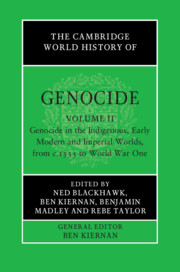Book contents
- The Cambridge World History of Genocide
- The Cambridge World History of Genocide
- The Cambridge World History of Genocide
- Copyright page
- Contents
- Figures
- Maps
- Tables
- Contributors to Volume ii
- Introduction to Volume ii
- Part I Settler Colonialism
- 1 ‘The Centrality of Dispossession’
- 2 A Very British Genocide
- 3 Settler Genocides of San Peoples of Southern Africa, c.1700–c.1940
- Part II Empire-Building and State Domination
- Part III Nineteenth-Century Frontier Genocides
- Part IV Premonitions
- Index
2 - A Very British Genocide
Acknowledgement of Indigenous Destruction in the Founding of Australia and New Zealand
from Part I - Settler Colonialism
Published online by Cambridge University Press: 23 June 2023
- The Cambridge World History of Genocide
- The Cambridge World History of Genocide
- The Cambridge World History of Genocide
- Copyright page
- Contents
- Figures
- Maps
- Tables
- Contributors to Volume ii
- Introduction to Volume ii
- Part I Settler Colonialism
- 1 ‘The Centrality of Dispossession’
- 2 A Very British Genocide
- 3 Settler Genocides of San Peoples of Southern Africa, c.1700–c.1940
- Part II Empire-Building and State Domination
- Part III Nineteenth-Century Frontier Genocides
- Part IV Premonitions
- Index
Summary
By 1837 the British government had been sending convicts, soldiers, and livestock entrepreneurs to Australia for almost fifty years. A committee of its own House of Commons, inspired by humanitarian principles, now reported the devastating effects on the indigenous inhabitants. Evidence of ‘extermination’ and ‘extirpation’ meant that the best minds of the Colonial Office were already exercised by the devastation of indigenous peoples inflicted by settlers who might have no clear aim of damaging them. When British government was extended to New Zealand, it was soon evident that Māori, for centuries sharing a largely common language and history, had a more effective capacity to resist than Aboriginal Australians, for millennia divided into hundreds of separate peoples and languages. In all Australian colonies and New Zealand, the determination of immigrants to ‘make productive’ land they knew belonged to others created disaster. Within twenty years of settlement, the Aboriginal population of Victoria declined by eighty percent. As the British spread over the whole continent, countless nations were extinguished. Across the Tasman the indigenous population was halved and the ‘passing of the Māori’ was still openly discussed even as adaptation, intermarriage and parliamentary representation saved it from genocide.
Keywords
- Type
- Chapter
- Information
- The Cambridge World History of Genocide , pp. 46 - 68Publisher: Cambridge University PressPrint publication year: 2023

